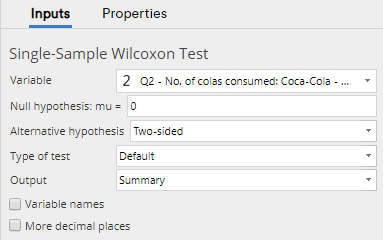Test - Nonparametric - Single-Sample Wilcoxon Test
Jump to navigation
Jump to search
Performs the Wilcoxon signed rank test to assess whether the median of the sample is equal to a specified value.
How to run this test
- In Displayr, go to Insert > More > Test > Nonparametric > Single-Sample Wilcoxon Test. In Q, go to Create > Test > Nonparametric > Single-Sample Wilcoxon Test
- Specify the variable to use under Inputs > Single-Sample Wilcoxon Test > Variable.
- Adjust options as per the notes below in the Object Inspector.
Example
An example output is shown below:
Options
Variable Sample to analyse.
mu Median of the variable, as assumed under the null hypothesis.
Alternative hypothesis Use a two-sided or one-sided test.
Type of test Method by which the p-value is computed.
Output
- Summary Shows a nicely formatted table of the test results (default).
- R The original text-based output from the wilcox.test function.
Variable names Display Variable Names in the output, instead of Variable Labels.
More decimal places Display numeric values with 8 decimal places.
Acknowledgements
Uses the wilcox.test function from the stats R package.
Code
var heading_text = "Single-Sample Wilcoxon Test";
if (!!form.setObjectInspectorTitle)
form.setObjectInspectorTitle(heading_text);
else
form.setHeading(heading_text);
form.dropBox({ label: "Variable",
types: ["Variable: Numeric, Date, Money, Categorical, OrderedCategorical"],
name: "formOutcomeVariable", prompt: "Select the Variable containing the sample" });
form.textBox({ label: "Null hypothesis: mu =", default_value: "0", name: "formMu", type: "number",
prompt: "Median of the variable, assumed under the null hypothesis" });
form.comboBox({ label: "Alternative hypothesis", alternatives: ["Two-sided", "Median < mu", "Median > mu"],
default_value: "Two-sided", name: "hypothesis", prompt: "Run a one-sided or two-sided test" });
form.comboBox({ label: "Type of test", alternatives: ["Default", "Exact", "Normal approximation", "Normal approximation with continuity correction"],
name: "type", default_value: "Default", prompt: "Method by which the p-value is computed" });
var formOutput = form.comboBox({ label: "Output", alternatives: ["Summary", "R"],
name: "formOutput", default_value: "Summary", prompt: "Select the output type" });
if (formOutput.getValue() == "Summary") {
form.checkBox({ label: "Variable names", name: "formNames", default_value: false,
prompt: "Display names instead of labels" });
form.checkBox({ label: "More decimal places", name: "formDecimals", default_value: false,
prompt: "Display numeric values with eight decimal places" });
}
library(flipFormat)
library(flipTransformations)
data <- AsNumeric(ProcessQVariables(QDataFrame(formOutcomeVariable)), binary = FALSE)
if (!is.null(QCalibratedWeight))
data <- data.frame(AdjustDataToReflectWeights(data, QCalibratedWeight))
Variable <- data[QFilter, 1]
test.output <- wilcox.test(Variable,
mu = as.numeric(formMu),
alternative = switch(hypothesis, "Two-sided" = "two.sided", "Median < mu" = "less", "Median > mu" = "greater"),
exact = switch(type, "Default" = NULL, "Exact" = TRUE, "Normal approximation" = FALSE, "Normal approximation with continuity correction" = FALSE),
correct = switch(type, "Default" = TRUE, "Exact" = FALSE, "Normal approximation" = FALSE, "Normal approximation with continuity correction" = TRUE))
single.sample.wilcoxon <- if (formOutput == "Summary") {
decimal.places <- if (formDecimals) 8 else NULL
SignificanceTest(test.output, "Single-Sample Wilcoxon Test",
list(formOutcomeVariable),
filter = QFilter, weight = QCalibratedWeight,
p.value.method = type,
show.labels = !formNames, decimal.places = decimal.places,
resample = TRUE)
} else
test.output
